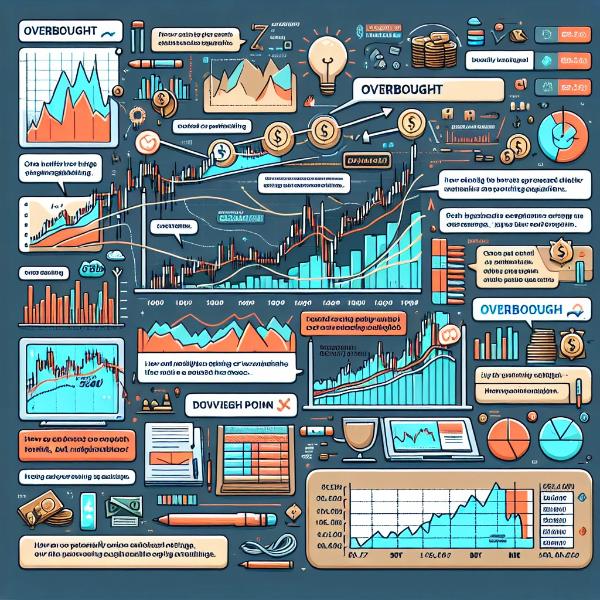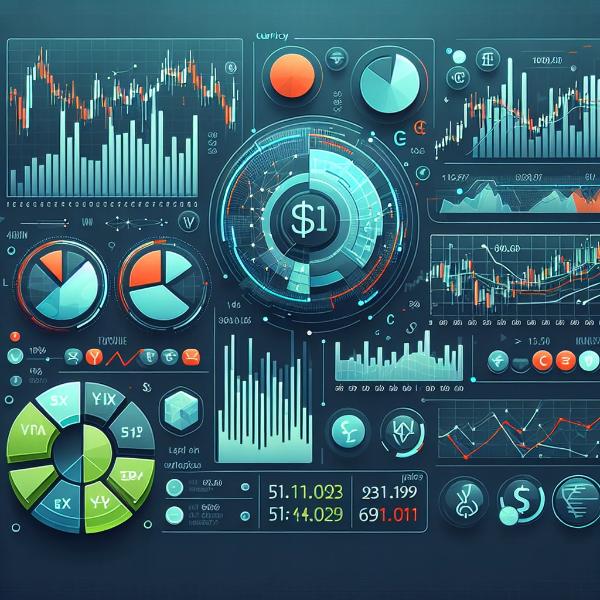Understanding Forex Overbought Conditions: How to Identify and Profit from Overbought Markets

How to Identify and Profit from Overbought Markets
Are you looking to maximize your profits in the forex market?
Understanding overbought conditions is a crucial skill that can help you identify profitable trading opportunities.
When a currency pair is considered overbought, it means that the price has risen too far and too fast, and a reversal may be imminent. This presents a unique opportunity for traders to take advantage of potential price corrections and make profitable trades.
But how can you identify overbought conditions?
One popular indicator is the Relative Strength Index (RSI), which measures the speed and change of price movements. When the RSI reaches a certain level, typically above 70, it indicates that the market is overbought and a reversal may be on the horizon.
By understanding and utilizing overbought conditions, you can position yourself to profit from market reversals and make informed trading decisions.
Don’t miss out on potential profits – learn how to identify and profit from overbought markets today!
Understanding Forex Overbought Conditions
When trading in the forex market, it is important to have a good understanding of overbought conditions. Overbought conditions occur when the price of a currency pair has risen too high and is likely to reverse or experience a correction. This can be a valuable signal for traders, as it indicates that the market may be due for a downward movement.
Identifying overbought conditions can be done using technical analysis indicators, such as the Relative Strength Index (RSI) or the Stochastic Oscillator. These indicators measure the momentum of price movements and can help traders determine when a currency pair is overbought.
When a currency pair is considered overbought, it means that there has been a significant increase in buying pressure, causing the price to rise rapidly. This can be caused by various factors, such as positive economic news or market speculation. However, it is important to note that overbought conditions do not necessarily mean that the price will immediately reverse. It is possible for a currency pair to remain overbought for an extended period of time before experiencing a correction.
Profiting from overbought markets requires careful timing and risk management. Traders can take advantage of overbought conditions by entering short positions or selling the currency pair. This allows them to profit from the expected downward movement in price. However, it is important to set stop-loss orders to limit potential losses in case the market does not reverse as expected.
It is also important to consider other factors when trading in overbought conditions. Traders should analyze the overall market trend, as well as any fundamental factors that may influence the price of the currency pair. By combining technical and fundamental analysis, traders can make more informed decisions and increase their chances of success.
In conclusion, understanding forex overbought conditions is crucial for successful trading. By identifying and profiting from overbought markets, traders can take advantage of potential downward movements in price. However, it is important to use technical analysis indicators, consider other market factors, and practice proper risk management to maximize profits and minimize losses.
What are overbought conditions?
Overbought conditions occur in the forex market when the price of a currency pair has risen too high and too quickly, based on technical indicators. This can happen when there is a surge in buying activity, causing the price to exceed its intrinsic value.
When a currency pair is considered overbought, it means that there is a high probability of a price reversal or correction in the near future. Traders and investors use various technical indicators, such as the Relative Strength Index (RSI) or Stochastic Oscillator, to identify overbought conditions.
Overbought conditions can be seen as a sign of market exhaustion, where buyers have pushed the price to unsustainable levels. This often leads to a period of consolidation or a downward price movement as sellers enter the market to take profits.
It is important to note that overbought conditions do not necessarily mean that the price will immediately reverse. It is possible for a currency pair to remain overbought for an extended period of time, especially in strong trending markets.
Traders who are able to identify overbought conditions can potentially profit by taking short positions or selling the currency pair, anticipating a price decline. However, it is crucial to use other technical analysis tools and indicators to confirm the overbought signal and to manage risk effectively.
Overall, understanding and being able to identify overbought conditions is an important skill for forex traders, as it can provide valuable insights into potential market reversals and profit opportunities.
Why are overbought conditions important in Forex trading?
Overbought conditions play a crucial role in Forex trading as they provide valuable insights into market dynamics and potential trading opportunities. When a currency pair is considered overbought, it means that the price has risen too far and too fast, indicating a possible reversal or correction in the near future.
Identifying overbought conditions is essential for traders as it helps them anticipate potential market reversals and adjust their trading strategies accordingly. By recognizing when a currency pair is overbought, traders can take advantage of the impending correction and position themselves to profit from the subsequent price decline.
Overbought conditions are typically identified using technical indicators such as the Relative Strength Index (RSI) or the Stochastic Oscillator. These indicators measure the strength and momentum of a currency pair’s price movement, allowing traders to determine whether it is overbought or oversold.
When a currency pair is overbought, it indicates that there is an excessive demand for the currency, causing its price to become overvalued. This imbalance between supply and demand often leads to a reversal in price as traders start to take profits or sell their positions, driving the price downwards.
By understanding and monitoring overbought conditions, traders can avoid entering trades at the peak of a price rally and instead wait for a more favorable entry point. This helps to minimize the risk of buying at inflated prices and increases the chances of making profitable trades.
Furthermore, overbought conditions can also serve as a signal for traders to consider short-selling or placing bearish trades. When a currency pair is overbought, it suggests that the upward momentum is weakening, making it more likely for the price to reverse and move downwards. Traders can take advantage of this by opening short positions and profiting from the anticipated price decline.
In conclusion, overbought conditions are important in Forex trading as they provide valuable insights into market dynamics and potential trading opportunities. By identifying and understanding overbought conditions, traders can adjust their strategies, minimize risks, and increase their chances of making profitable trades.
The impact of overbought conditions on price movements
When a market becomes overbought, it means that the demand for a particular asset or security has exceeded its supply. This often occurs when there is a surge in buying activity, causing the price to increase rapidly. However, this excessive buying can lead to a situation where the asset is overvalued and the price is likely to decline in the near future.
Overbought conditions can have a significant impact on price movements. When a market is overbought, it is a signal that the buying pressure is unsustainable and a correction may be imminent. Traders and investors who recognize this condition can take advantage of it by selling their positions or opening short positions to profit from the expected price decline.
One of the key indicators used to identify overbought conditions is the Relative Strength Index (RSI). The RSI measures the speed and change of price movements and provides a numerical value between 0 and 100. A reading above 70 is generally considered overbought, indicating that the asset is likely to experience a price reversal.
Overbought conditions can also lead to increased volatility in the market. As more traders and investors start to sell their positions, the selling pressure can intensify, causing the price to drop rapidly. This can create opportunities for traders who are able to capitalize on short-term price fluctuations.
It is important to note that overbought conditions do not always result in a significant price decline. In some cases, the market may continue to rise despite being overbought, especially in strong bullish trends. Therefore, it is crucial for traders to use other technical indicators and analysis tools to confirm the likelihood of a price reversal.
In conclusion, overbought conditions can have a profound impact on price movements. Traders and investors who are able to identify and profit from these conditions can take advantage of potential price reversals and short-term trading opportunities. However, it is important to use additional analysis tools and indicators to confirm the likelihood of a price reversal and to manage risk effectively.
Identifying Overbought Markets
Identifying overbought markets is crucial for successful forex trading. When a market is considered overbought, it means that the price has risen too high and is likely to experience a correction or a reversal in the near future. This presents an opportunity for traders to profit from the expected price decline.
There are several indicators and techniques that can help identify overbought markets:
- RSI (Relative Strength Index): The RSI is a popular technical indicator that measures the speed and change of price movements. When the RSI reaches a level above 70, it indicates that the market is overbought and a reversal may occur.
- Stochastic Oscillator: The stochastic oscillator is another widely used indicator that compares the current price to its range over a specific period of time. When the stochastic oscillator rises above 80, it suggests that the market is overbought and a potential reversal might be imminent.
- Volume Analysis: Monitoring the trading volume can also provide insights into overbought conditions. If the volume increases significantly while the price continues to rise, it could indicate that the market is becoming overbought.
- Trendlines: Drawing trendlines on a price chart can help identify overbought markets. When the price consistently reaches the upper trendline, it suggests that the market is overbought and a reversal may be likely.
It is important to note that identifying overbought markets is just the first step. Traders should also consider other factors such as market sentiment, fundamental analysis, and risk management before making any trading decisions.
By effectively identifying overbought markets, traders can take advantage of potential price reversals and profit from the market’s movements.
Using technical indicators to identify overbought conditions
Technical indicators are powerful tools that can help traders identify overbought conditions in the forex market. These indicators are mathematical calculations based on historical price data and can provide valuable insights into market trends and potential reversals.
One popular technical indicator used to identify overbought conditions is the Relative Strength Index (RSI). The RSI measures the speed and change of price movements and ranges from 0 to 100. A reading above 70 is typically considered overbought, indicating that the market may be due for a downward correction.
Another commonly used indicator is the Stochastic Oscillator. This indicator compares the closing price of a currency pair to its price range over a certain period of time. When the Stochastic Oscillator is above 80, it suggests that the market is overbought and a reversal may be imminent.
Additionally, the Moving Average Convergence Divergence (MACD) indicator can be helpful in identifying overbought conditions. The MACD measures the relationship between two moving averages and can signal potential trend reversals. When the MACD line crosses above the signal line and both lines are above zero, it may indicate an overbought market.
Traders can also use Bollinger Bands to identify overbought conditions. Bollinger Bands consist of a middle band, which is a moving average, and two outer bands that are standard deviations away from the middle band. When the price touches or exceeds the upper band, it suggests that the market is overbought and a reversal may occur.
It is important to note that no single indicator is foolproof, and traders should use a combination of indicators and other analysis techniques to confirm overbought conditions. Additionally, it is crucial to consider other factors such as market sentiment and fundamental analysis when making trading decisions.
By utilizing these technical indicators, traders can gain a better understanding of overbought conditions in the forex market and potentially profit from market reversals.
Common indicators for identifying overbought conditions
When trading in the forex market, it is important to be able to identify overbought conditions in order to make informed trading decisions. Overbought conditions occur when the price of a currency pair has risen too far and too fast, and may be due for a correction or reversal. There are several common indicators that traders use to identify overbought conditions:
- Relative Strength Index (RSI): The RSI is a popular momentum oscillator that measures the speed and change of price movements. A reading above 70 is generally considered overbought, indicating that the currency pair may be due for a downward correction.
- Stochastic Oscillator: The stochastic oscillator is another popular momentum indicator that compares a currency pair’s closing price to its price range over a specified period of time. A reading above 80 is typically considered overbought, suggesting that the currency pair may be due for a reversal.
- Commodity Channel Index (CCI): The CCI is a versatile indicator that measures the current price level relative to an average price level over a specified period of time. A reading above +100 is often seen as overbought, indicating that the currency pair may be due for a pullback.
- Bollinger Bands: Bollinger Bands consist of a middle band (usually a simple moving average) and two outer bands that are standard deviations away from the middle band. When the price of a currency pair reaches the upper band, it is often considered overbought and may be due for a reversal.
These are just a few of the common indicators that traders use to identify overbought conditions in the forex market. It is important to note that no single indicator is foolproof, and it is often best to use a combination of indicators and other technical analysis tools to confirm overbought conditions before making trading decisions.
By understanding and utilizing these indicators, traders can better identify and profit from overbought markets in the forex market.
Question-Answer:
What is the book “Understanding Forex Overbought Conditions How to Identify and Profit from Overbought Markets” about?
The book is about understanding and profiting from overbought conditions in the forex market. It teaches readers how to identify when a market is overbought and provides strategies for profiting from these situations.
Who is the author of “Understanding Forex Overbought Conditions How to Identify and Profit from Overbought Markets”?
The author of the book is an experienced forex trader who has successfully identified and profited from overbought conditions in the market. Their expertise is shared in this book to help others do the same.
What are overbought conditions in the forex market?
Overbought conditions in the forex market occur when the price of a currency pair has risen too quickly and too far, resulting in a potential reversal or correction. These conditions indicate that the market may be overvalued and due for a downward movement.
How can I identify overbought conditions in the forex market?
There are several indicators and tools that can help identify overbought conditions in the forex market. Some common ones include the Relative Strength Index (RSI), Stochastic Oscillator, and Bollinger Bands. These indicators can show when a currency pair is overbought and potentially due for a reversal.
What strategies are provided in the book for profiting from overbought markets?
The book provides various strategies for profiting from overbought markets, including trend reversal trading, mean reversion trading, and breakout trading. Each strategy is explained in detail, with examples and step-by-step instructions on how to implement them in the forex market.
What is the book “Understanding Forex Overbought Conditions” about?
The book “Understanding Forex Overbought Conditions” is about how to identify and profit from overbought markets in the Forex market. It provides insights and strategies for traders to take advantage of overbought conditions.
Who is the author of “Understanding Forex Overbought Conditions”?
The author of “Understanding Forex Overbought Conditions” is an experienced Forex trader and expert in technical analysis. The book reflects their knowledge and insights gained from years of trading in the Forex market.
What are overbought conditions in the Forex market?
Overbought conditions in the Forex market occur when the price of a currency pair has risen too far and too fast, leading to a potential reversal or correction. It indicates that buying pressure has become exhausted and a downward movement may be imminent.
How can I identify overbought conditions in the Forex market?
There are several indicators and tools that can help identify overbought conditions in the Forex market. Some commonly used indicators include the Relative Strength Index (RSI), Stochastic Oscillator, and Moving Average Convergence Divergence (MACD). These indicators measure the momentum and strength of a price movement and can signal when a currency pair is overbought.
What strategies can I use to profit from overbought markets in Forex?
There are various strategies that traders can use to profit from overbought markets in Forex. Some common strategies include short selling or entering a sell trade when a currency pair is overbought, using trendlines and support/resistance levels to identify potential reversal points, and using oscillators and other technical indicators to confirm overbought conditions before entering a trade.
What is the book “Understanding Forex Overbought Conditions” about?
The book “Understanding Forex Overbought Conditions” is about how to identify and profit from overbought markets in the Forex market. It provides insights and strategies for traders to take advantage of overbought conditions and make profitable trades.
How can I identify overbought conditions in the Forex market?
To identify overbought conditions in the Forex market, you can use technical indicators such as the Relative Strength Index (RSI) or the Stochastic Oscillator. These indicators measure the momentum of price movements and can indicate when a currency pair is overbought. Additionally, you can look for other signs such as a sharp increase in price or a divergence between the price and the indicator.






